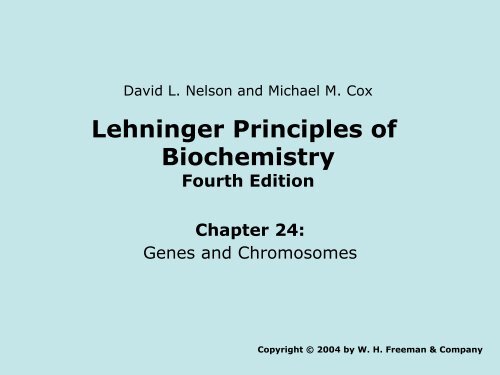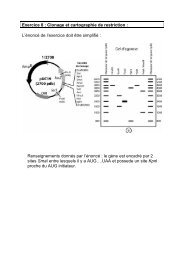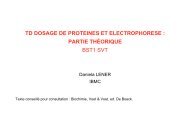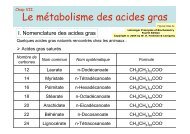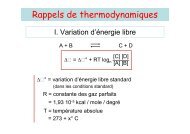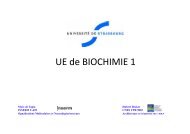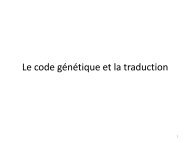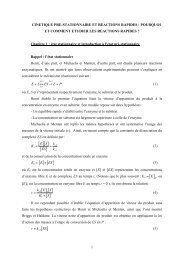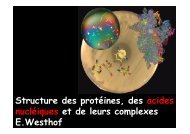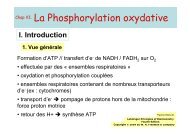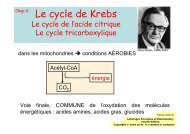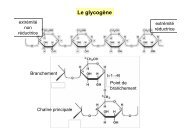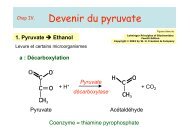Lehninger Principles of Biochemistry - IBMC
Lehninger Principles of Biochemistry - IBMC
Lehninger Principles of Biochemistry - IBMC
Create successful ePaper yourself
Turn your PDF publications into a flip-book with our unique Google optimized e-Paper software.
One gene - one enzyme
Yeast (16 chromosomes) masses from 1,5x10 8to 1x10 9 Daltons From 230 000 to 1532 0000 bp Human chromosomes up to 279 10 6 bp Each diploid cell 2 m <strong>of</strong> DNA 10 14 cells /body > 2x10 11 km (earth circumference 4x10 4 km Earth-sun 1,5x10 8 km)
2 micron 1,7 mm
Circular plasmid
A dividing mitochondrion
DNA topology The same doublestrandedDNAmolecule can havedifferentconformations Relative radius <strong>of</strong> gyrationLinear>circles>supercoils Frictional coefficient influences electrophoretic mobility andsedimentation rate. Linear open Circular Supercoiled
84 bp at 10.5/turn
L, T, and W characterize superhelicalL= linking number = number<strong>of</strong> times one strand wrapsaround the other. It is aninteger for a closed circularDNA.DNA T = twists/turns in the DNA( No. bp/10.4; positive forright-handed DNA W = writhes =number <strong>of</strong> turns<strong>of</strong> the helix around thesuperhelical axis T = 26 W = 0 L = T + W What kind <strong>of</strong> number is L??
Naturally occurring superhelical DNA isunderwound Note that there are _____ bp/turn in negatively supercoiled DNA
Detecting different DNA topoisomers A. Electrophoretic mobility B. Sedimentation rate Which form goes fastest in each technique?
Detecting different DNA topoisomers C. Binding <strong>of</strong> dyes: ethidium bromide in UpA: an example <strong>of</strong> an________________ agent.
Detecting different DNA topoisomers Sedimentation rate A B C (Ethidium bromide concentration) Supercoiled>open>supercoiled (negative) (______) Gel electrophoresis <strong>of</strong> a mixture <strong>of</strong> linear, open, and supercoiled DNA treated with EBTop (-) Linear/open topoisomers Bottom (+)
Topoisomerases change the linkingnumber <strong>of</strong> superhelical DNA Type I topos change L in units <strong>of</strong> one by breaking a single strand<strong>of</strong> DNA and allowing the duplex to unwind. Type II topos change L in units <strong>of</strong> two by breaking both strandsand allowing a pass-through <strong>of</strong> both strands <strong>of</strong> the double helix.
Type I topoisomerases (nicking-closingenzymes) DNA (n turns) + topoisomerase >covalent DNA-enzyme intermediate> dsDNA (n-1 turns) + topoisomerase The formation <strong>of</strong> a covalent DNA- enzyme complex preserves the free energy <strong>of</strong> the phosphodiester bind in DNA as a phosphodiester bond between DNA and Tyrosine. (What other amino acid mightfunction instead <strong>of</strong> tyrosine?)
Covalent intermediate Active-site tyrosine attacks DNAphosphate! Forms transient phosphotyrosine!ONHOOPOO–H5´HOOHHBaseHBIOL401 DNA Topology 2005!Dr Andy Bates!
Classification <strong>of</strong> topos Type IA!Cleaves one strand!5´-phosphotyrosine linkage!∆Lk = ± 1! Type IB!Cleaves one strand!3´-phosphotyrosine linkage!∆Lk = ± 1!!BIOL401 DNA Topology 2005!Dr Andy Bates!
Structure and mechanism Type IA!Monomeric (97 kDa; E. coli)!Only binds to -ve supercoils!Works by strand-passage (decatenation)!BIOL401 DNA Topology 2005!Dr Andy Bates!
Type IA mechanismBIOL401 DNA Topology 2005!Dr Andy Bates!
Structure and mechanism Type IB!Approx 90 kDa!Monomeric!Binds to +ve and -ve supercoils!no DNA distortion!!BIOL401 DNA Topology 2005!Dr Andy Bates!
Type IB mechanism'cap' lobeDNA (end on)'catalytic' lobeside viewBIOL401 DNA Topology 2005!Dr Andy Bates!
Model <strong>of</strong> DNA topo I (Ec N-terminus) Note relative size <strong>of</strong> the enzymecompared to the cross section <strong>of</strong>the DNA helix, and how the enzyme encircles and holds the DNA. Tyrosine (Y) Position <strong>of</strong> active site tyr. How does it contact DNA? How do we know it is this amino acid?
Classification <strong>of</strong> topos Type II!Cleaves both strands (4 bp stagger)!5´-phosphotyrosine!∆Lk = ± 2!ATP-dependent!BIOL401 DNA Topology 2005!Dr Andy Bates!
Proposedmechanism <strong>of</strong> topoII
Prokaryotic Topoisomerase II is a DNAgyraseIn the presence <strong>of</strong> ATPDNA gyrase can createsupercoils; it can relaxsupercoils in theabsence <strong>of</strong> ATP ATP +AMP, PPi Relaxed circle Supercoiled circle
Inhibitors <strong>of</strong> DNA gyrase inhibit DNATwo antibiotics,oxolinic acid andnovobiocin inhibitreplication. replication E. coli- Nov S E. coli- Nov S topoII Nov S topoII Nov R Mutants resistant to novobiocin have a novobiocin-resistant topo II activity in vitro, thus provingthat the lethal activity <strong>of</strong> the drug is its inhiition <strong>of</strong> DNA topo II activity in vivo. This demonstrates that topo II is an (essential/non- essential) enyme for cell viability.
Type II mechanismT segment+ATPG segmentG segmentT segment-ADP, PiBIOL401 DNA Topology 2005!Dr Andy Bates!
How gyrase supercoils Gyrase wraps DNA around complex!T-segmentG segmentBIOL401 DNA Topology 2005!Dr Andy Bates!
Structure and mechanism Type II!Dimeric (approx. 170-190 kDa)!Tetrameric in bacteria!Interacts with 2 DNA segments!ATP-dependent clamp!BIOL401 DNA Topology 2005!Dr Andy Bates!
Gyrase and Type IIsTOP2YATPase92-kDa structureS. cerevisiae topoisomerase II (164 kDa)GyrBYGyrAATPasewrapping43-kDa structureinsert59-kDa structureE. coli GyrB (90 kDa) and GyrA (97 kDa)StructuresBIOL401 DNA Topology 2005!Dr Andy Bates!
Drug interactions Bacterial type IIs (gyrase and topo IV)!CH 3CH 3OOO OCH 3 OH 2 NOOOHOHNHOHnovobiocinOCOOHFOCOOHNNC 2 H 5HNNNnalidixic acidBIOL401 DNA Topology 2005!cipr<strong>of</strong>loxacinDr Andy Bates!
Effect <strong>of</strong> quinolone drugsABBAQuinoloneAQBBQAtrapped covalent complexDenatureBIOL401 DNA Topology 2005!Dr Andy Bates!
Anti-tumour agentsH 3 CHOOOOHOOHOHO O OH 3 CONHOOHOHNcamptothecinOH 3 COOOHOOOOOOH 3 CNH 3+OHadriamycinH 3 COetoposide (VP-16)OHOCH 3BIOL401 DNA Topology 2005!Dr Andy Bates!
Summary DNA exists in different topological formsin vivo and in vitro DNA topoisomerases catalyze theinterconversion <strong>of</strong> DNA forms Negative superhelicity (underwinding)helps proteins bind DNA by favoringunwinding <strong>of</strong> the helix.
Variation d’enlacement ΔL = L -L° L° = L(initial)° L = T +W ΔL = (T+W) - (T°+W°) W° = 0 (par définition) ΔL = (T+W) - T° ΔL = ΔΤ +W L est un invariant topologique (pour le changer il faut couper un des brins)
Un plasmide circulaire relaxé a 9090 paires de bases. En variant un paramètrephysico-chimique, 60 paires de bases adoptent la forme ZQuel sera alors le nombre de supertours du plasmide?Il n’y a pas de changement du nombre d’enlacement (l’ADN n’a pas étécoupé). Donc, commeΔL = ΔΤ +W avec ΔL = 0 W = - ΔT ΔT = T(état avec Z) - T(initial) T(initial) = 9090/10 (si 10 pdb/tour) T(état Z)= (9090-60)/10 - 60/12 (12 pdb/tour pour forme gauche Z) ΔT = - 11 >> W = + 11 Introduction de 11 supertours positifs
En partant du plasmide relaxé, combien de paires de bases devraient adopter laforme A pour obtenir le même topoisomère?Soit x le nombre de paires de bases qui devraient passer en forme A (avec 11bases par tour) On a+ 11 = -ΔΤ ΔT = Τ(état Α) - T(état initial) ΔT = T(état initial) - Τ(état Α)+ 11 = 9090/10 - ((9090-x)/10 + x/11) + 11 = 9090/10 - (9090-x)/10 - x/11 >> x = 1210 bases
Effet d’un intercalantSi chaque molécule de bromured’éthidium intercalée détourne ladouble hélice de 26°, combien faut-il demolécules de bromure d’éthidium pourdiminuer le nombre d’enlacementd’une unité?


